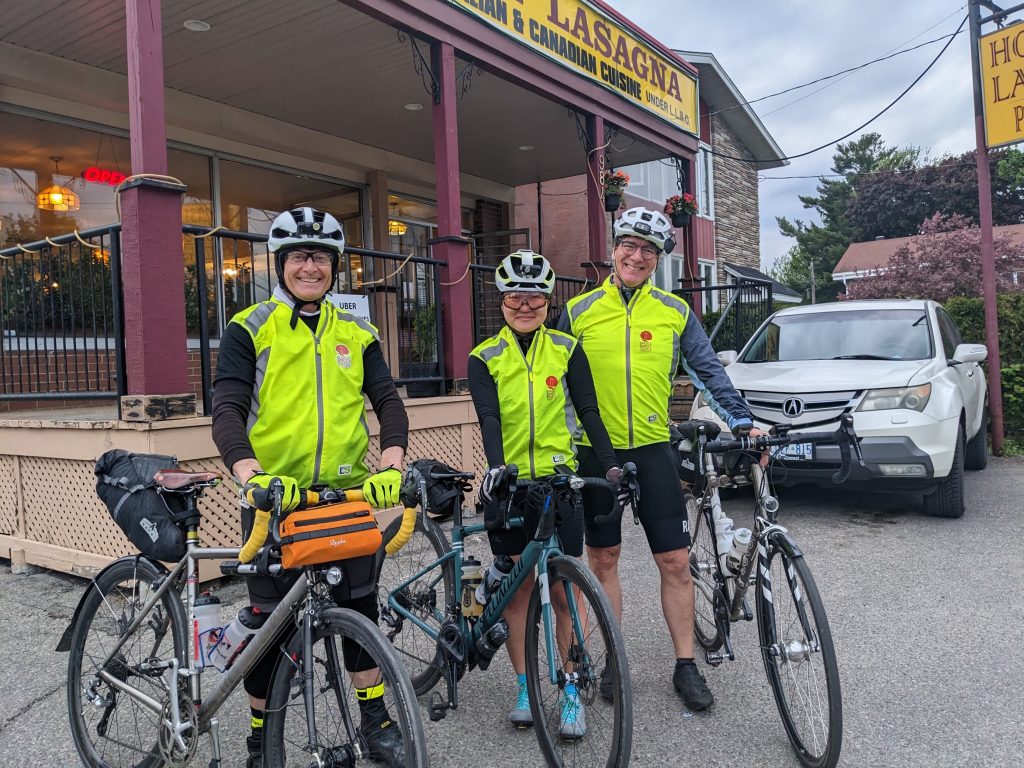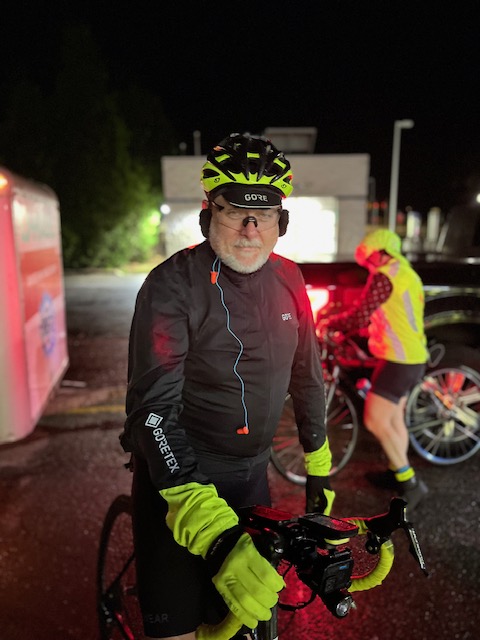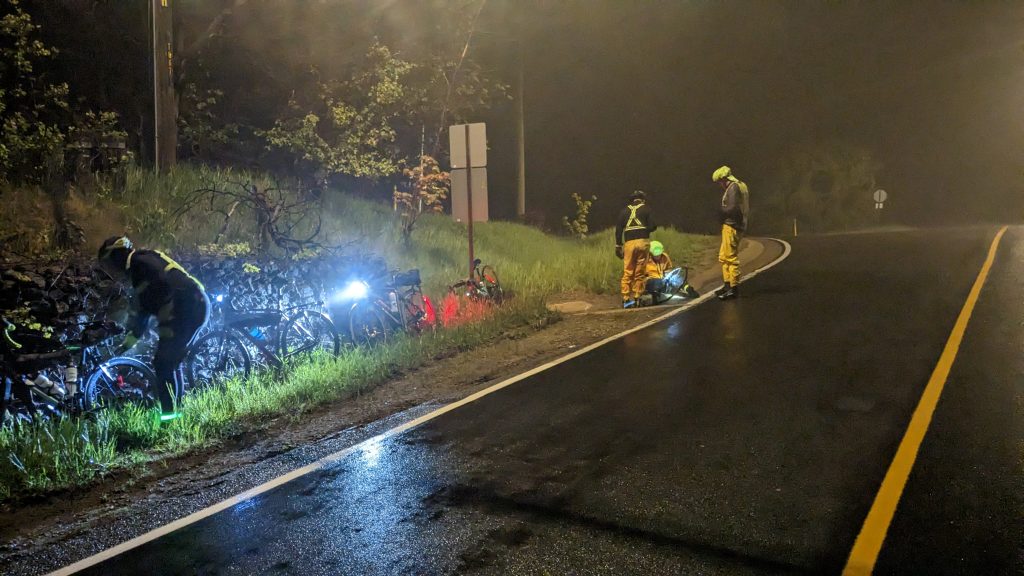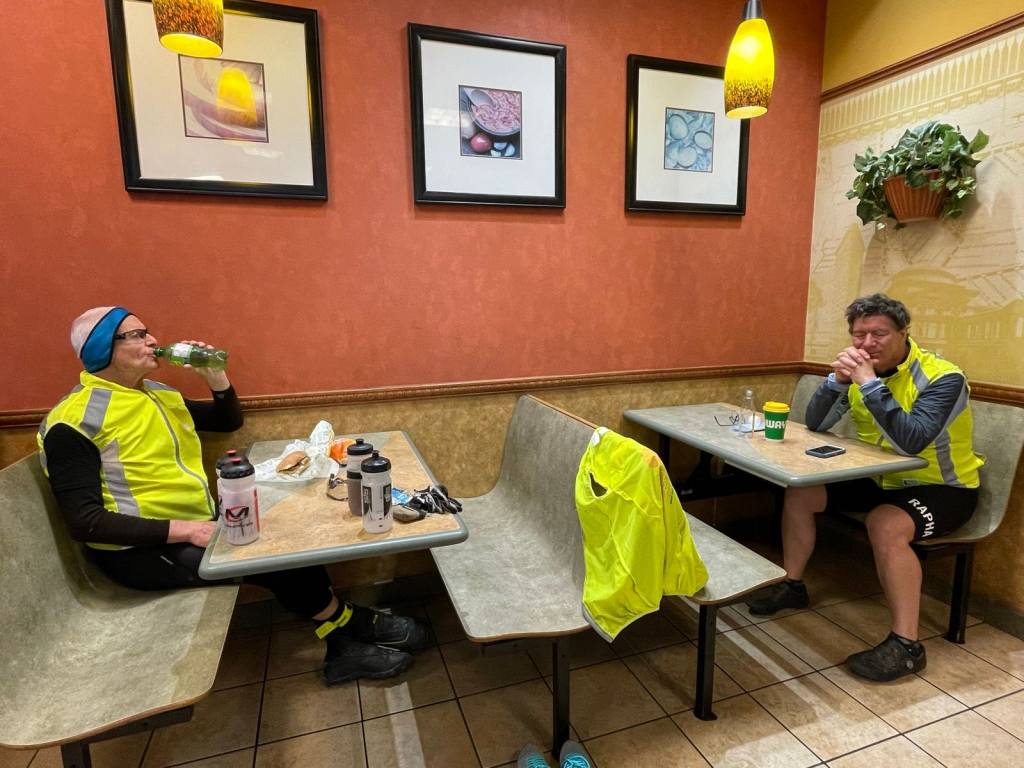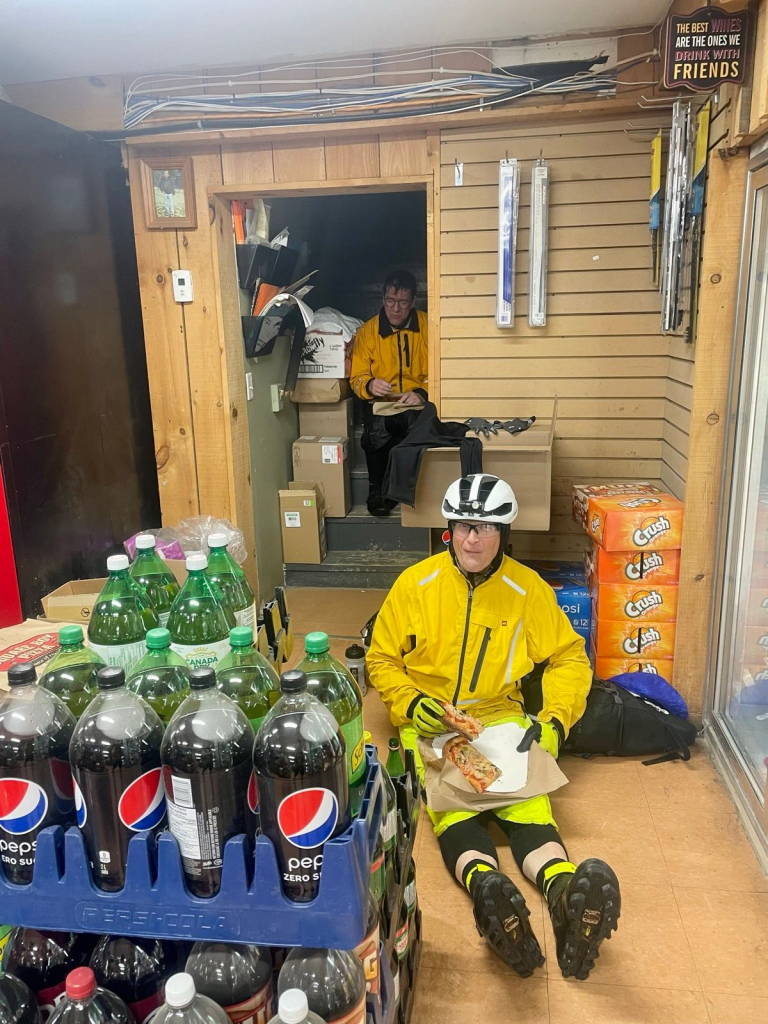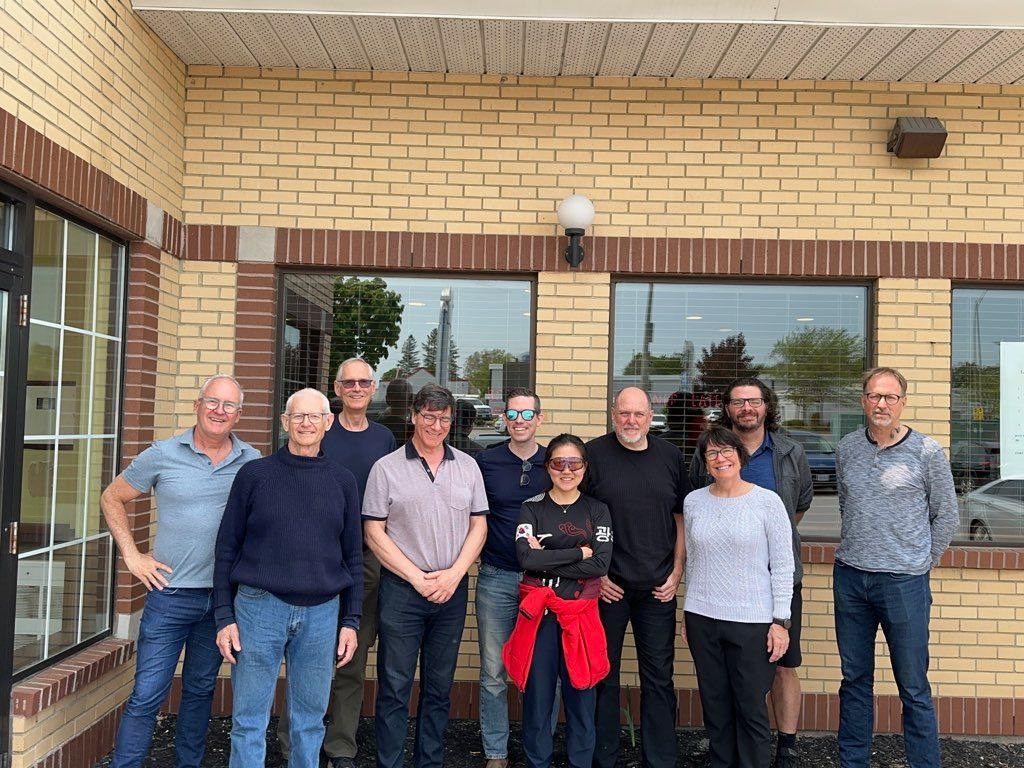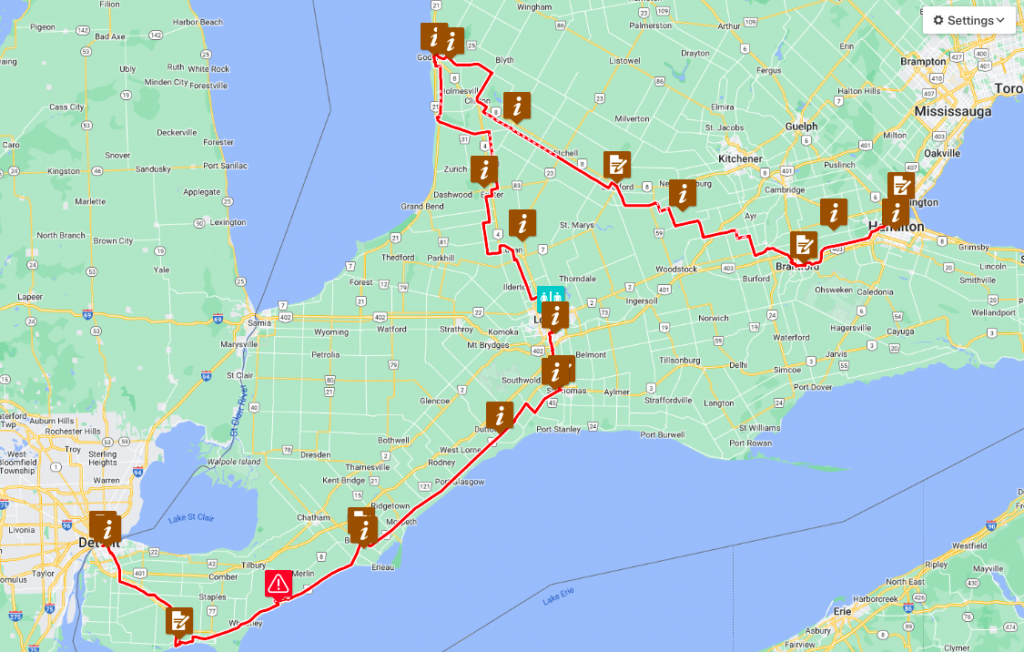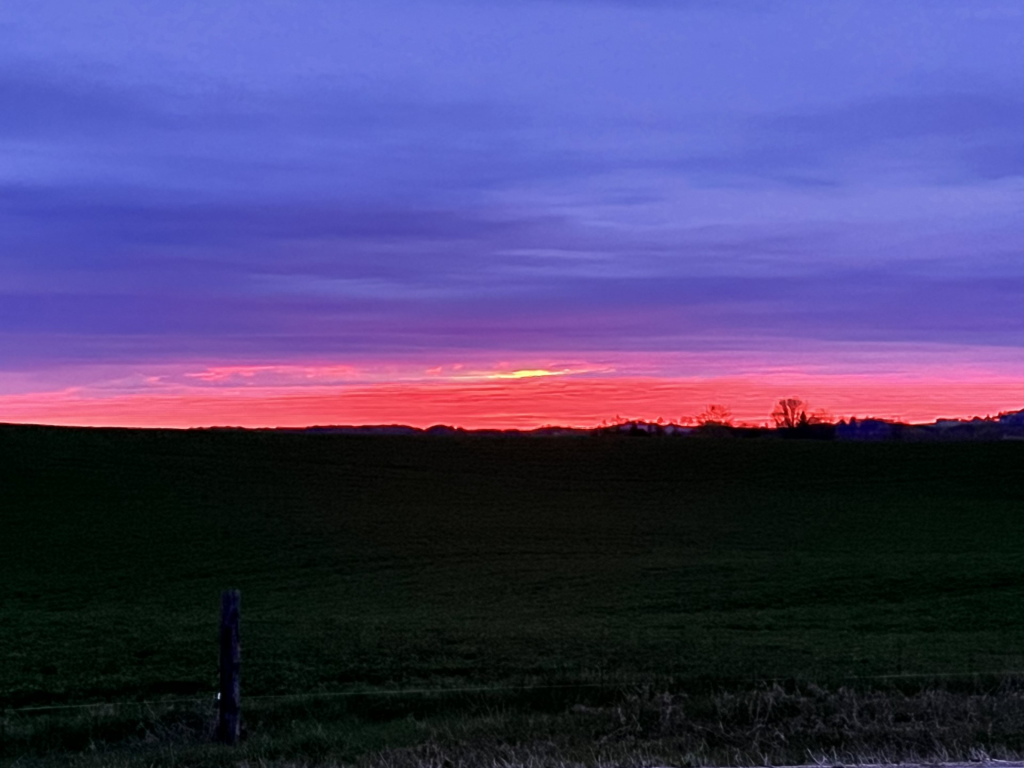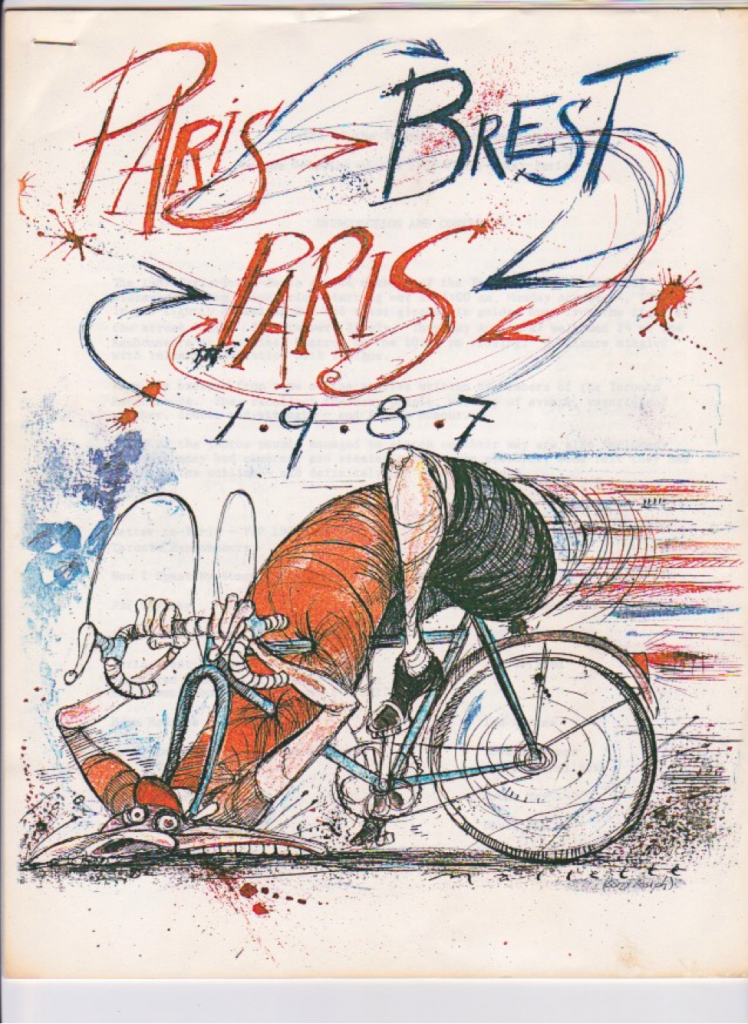
This ride report is co-narrated by Fred Chagnon and JungAh Hong, two randonneurs representing each of the participating teams in the 2023 Randonneurs Ontario Fleche Event. In this event, two teams departed on the evening of Friday May 19th, and rode for 24 hours until the evening of Saturday May 20th.
Though coming from opposite directions, the two teams would aim to meet at the predetermined destination of Belleville, Ontario.
=-=-=-=-=- The Teams –=-=-=-=-=
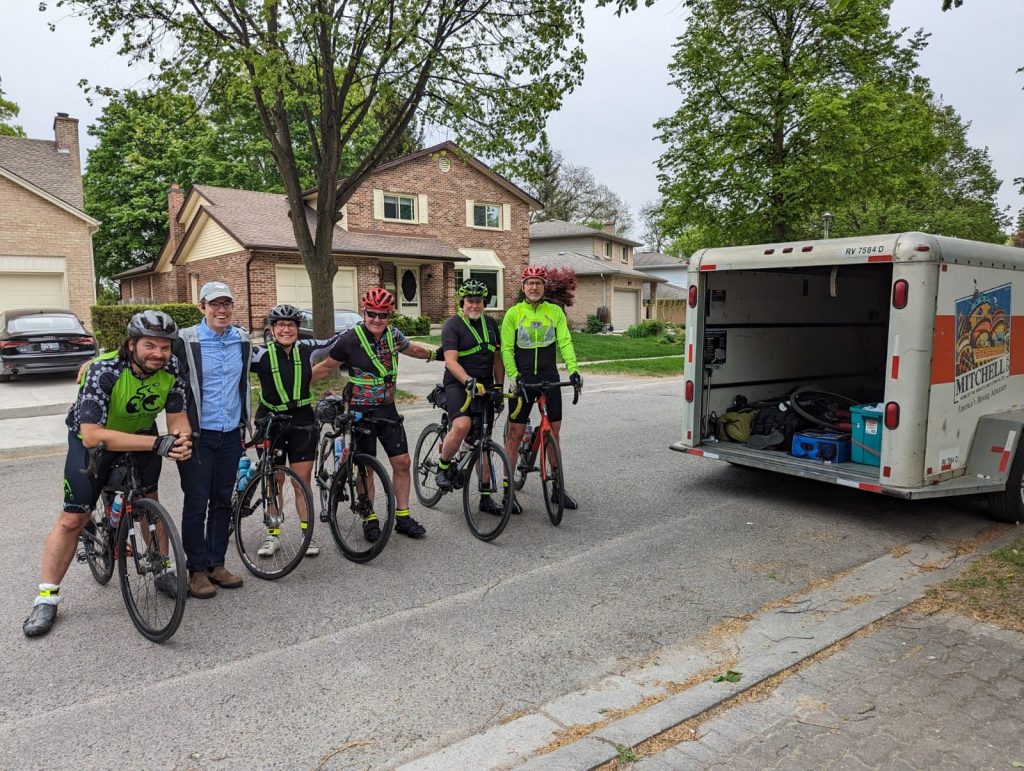
Team: Les Quintuplets de Belleville (Huron)
Members: Fred Chagnon, Dave Cole, Marc Deshaies (SAG), Tim O’Callahan, Brenda Wiechers-Maxwell, Rob Thibert
Starting Point: London, Ontario
FRED: Les Quintuplets de Belleville was a Huron Chapter team jointly spear-headed by Tim O’Callahan and Brenda Wiechers-Maxwell. It was mostly a reprise of their 2022 team Dropping Ants, but with a few notable changes. Dave Cole was a shoe-in to return to the team, but Darcy Haggith and John Kieffer were both unavailable this year leaving two spots open. I’d learned that I had a place as early as last year while helping Tim and Brenda with their 2022 route. I casually said that I’d be honored to run SAG for them the following year, figuring that would be a great way to see what the Fleche was all about. Brenda’s reply was as clear as it was immediate: “You can’t SAG for us next year. You’re going to be riding with us, silly.”
Marc Deshaies was the fifth rider. However, after suffering stomach cramps that caused him to DNF on the Wind-Del Velodrome 200km brevet in late April, Marc had his appendix removed and was unable to ride for the time being. The final spot was then filled by Robert Thibert. Marc did stay on as our SAG operator. So the Huron team in truth consisted of six club members; five riders and one running support.
Team: Les Mangeurs de Fleche (Ottawa)
Members: Peter Grant, JungAh Hong, Guy Quesnel
Starting Point: Ottawa, Ontario
JUNGAH: We were happy to hear that the Fleche was being hosted in Belleville, since this destination provides for great riding options from the Ottawa region. Ottawa is a comparatively small chapter when compared to Huron and Toronto but even still we tried to build two teams of at least three riders to participate in this event. Peter Grant, Guy Quesnel and I formed Les Mangeurs de Fleche. Vytas Januaskas and Nick Uloth were also putting together a second team, but in the end these two had to each re-double their efforts on qualifying for Paris-Brest-Paris and were unable to balance this against the requirement to run this 360+km course here. And so, we wound up with a single team in the end.
=-=-=-=-=- The Routes -=-=-=-=-=
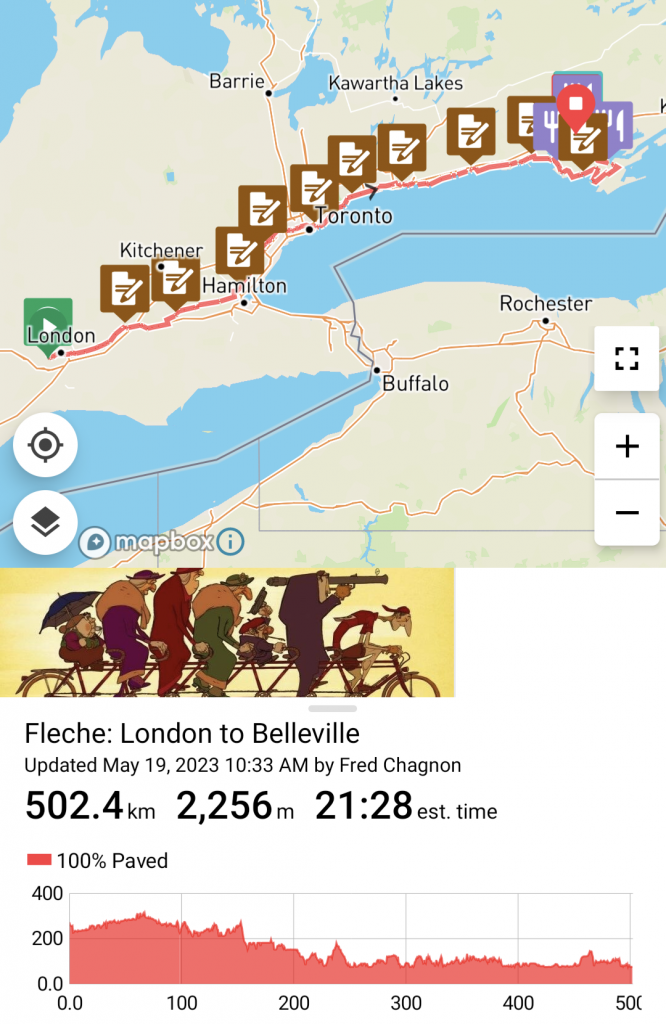
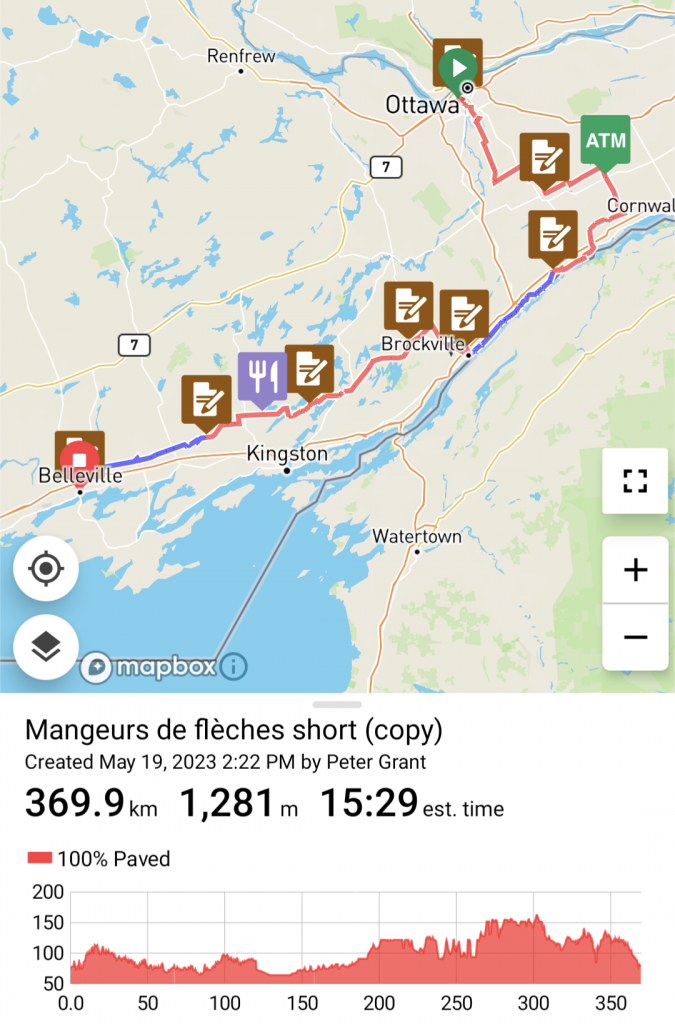
=-=-=-=-=- The Rides -=-=-=-=-=
FRED: Our route was set to leave from Boler Mountain, an inner-city ski/mountain bike resort right next to my home in London. We chose London because the team’s goal was to make it 500kms to Belleville. So our planned route was a straight shot east through the Greater Toronto Area, and then a quick tour of Prince Edward County before arriving at the mark in Belleville.
I fired up my Garmin, then sent the posted the LiveTrack link to the #general channel in Slack (the club’s communication and collaboration hub), so that others could dot-watch us.
We set off right on schedule at 18:00, the five riders taking a pedestrian path into the ski resort parking lot, and Marc pulling the trailer out of the neighbourhood bound for our first control in Woodstock 60 clicks away. As if on cue, a light drizzle also formed as we meandered through the residential neighbourhood of west London. Our ride began on London’s Thames Valley Parkway multi-use path which follows the river across the entire city, saving us from traffic stops and any climbing. I’d been worried about people traffic slowing us down here but that little bit of mist seemed like enough to ward off all the casual walkers. We maintained a decent pace together, arriving at an in-town Tim Horton’s in just over an hour. This seemed pretty quick to be our 60km control, and when we saw no sign of our SAG wagon we realized we were only in Ingersol, with still 25km to go to Woodstock. Somewhere between the two towns Rob started spontaneously singing. I, of course joined in. I hadn’t spent much time on the road with him, having only met him briefly on a 200 a year prior, but this was the moment I knew why Brenda and Tim brought him in. Rolling karaoke is a great way to eat up the miles, and I appreciated the culture fit.
It was shortly after 20:00 when Marc called me, having noticed we were getting close. He gave me some cues on where he managed to station the SAG and I put in an order at the Tim Horton’s on everyone’s behalf so we could keep the control as quick as possible. 60kms down in 2:20 – not a bad pace at all to start.
* * *
JUNGAH: Our scheduled depart was set for 20:00 Friday night. Our team had considered delaying the start until Saturday morning, but since it looked like it was going to rain no matter what we figured there was no point in waiting and decided to keep our start time close to that of the other team. Guy, Peter and I all live within a ten minute drive from each other so we agreed to meet for dinner at a nearby restaurant and make that our start point. Vytas and his wife Colleen also joined us for dinner and give us a good send-off and the two were also planning to meet us at our arrival point in Belleville.
We set off on schedule at 8PM. The ride out of Ottawa was dry, and the headwind we thought we’d have to fight through the farmland was quieting down. We still had some daylight ahead of us, but I knew that, come nightfall, my struggle would be staying awake on the bike. Guy and Peter both have a lot of night riding experience so I wasn’t too worried about them but even through all my own experience, I personally have a lot of trouble staying awake when it gets dark.
By nightfall we were pulling into Winchester, the site of our first control. We’d been riding for 67kms, and the control was a Circle K. But although being advertised as 24 hours, it was closed. (These closed 24 hour stops would become a recurring these on this ride). Our next control was just over 30kms away, and it was just an ATM, so we knew we had to find another spot here in Winchester. Honestly, all I cared about was to stop talking and keep moving because the mosquitos were eating me alive! Peter, who knew the route best, said there was service in the form of a Tim Horton’s or gas station off-route to the west, we deviated from our set course slightly and went there instead.
* * *
FRED: We only had 35kms to cover between Woodstock and our next control in Paris. These short hops were a course design choice made to accommodate the fact that we had full support. Best to have access to the Uhaul at many shorter intervals than having to go for hours between supported stops. The Paris control was a 24hr Pioneer gas station. Marc had received permission to park under the canopy that sheltered the pumps from the rain, as the station wasn’t seeing much traffic at 10PM.
Soaked as we were, it was noted at this point that I was the only one in the team not wearing any rain gear. “Well..I’m not going to get any wetter than I am right now, am I?” was all I could think to say. (Not sure my team appreciated me tempting the heavens like this).
It was on the way to the ironically-named town of Waterdown that I bore witness to a phenomenon I’d never seen before: frogs on the road! And I don’t mean seeing a frog every once in awhile — I mean we were actively watching the glow of our headlights, actively dodging frogs we would see a few times a minute! At one point, what I thought was a large boulder in the shoulder, was confirmed by Tim to have been an oversized bullfrog! (Honestly if it wasn’t for the fact that it was pouring rain I might have gone back for a look).
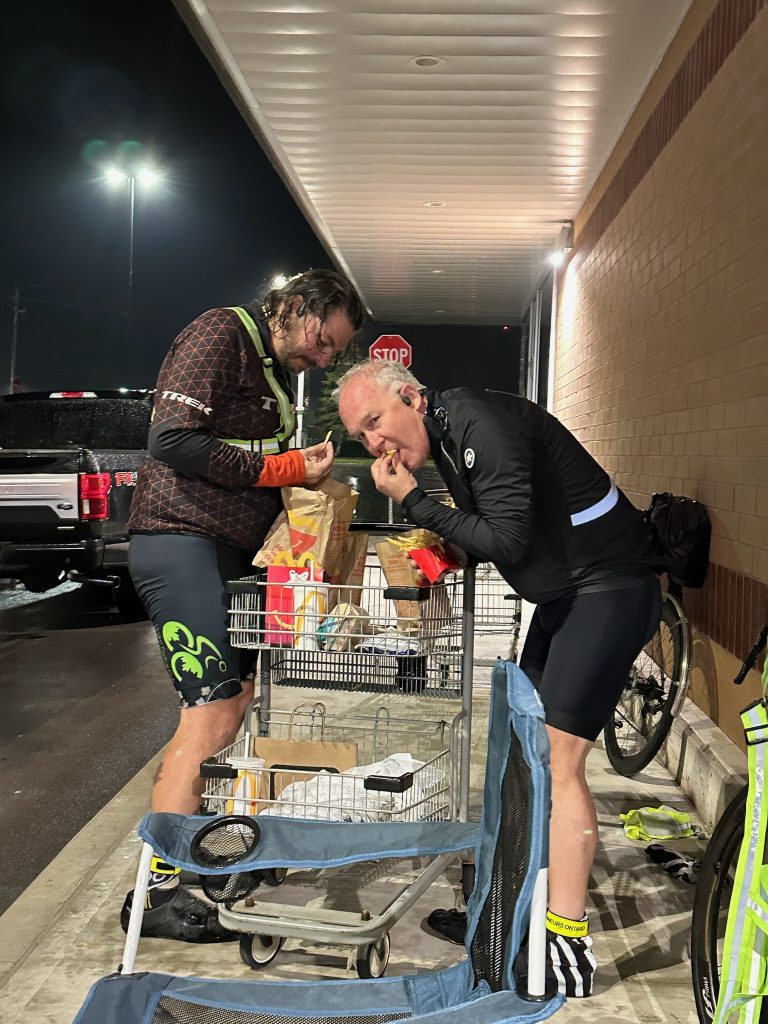
Marc called as we were pulling in close to the control. He mentioned he’d parked the trailer under the overhang of a Fortino’s grocery store, and while the Tim Horton’s was closed, the McDonald’s drive-through was open. I worked my way around the pack taking orders that he could make on our behalf. Team work makes the dream work!
We pulled into the Fortino’s plaza in Waterdown and leaned our bikes up against the building under the overhang. Once again it seemed like everyone but me took their turn entering the Uhaul and exiting having done a complete costume change. “Fred – are you sure you don’t want something dry? I’m sure we have something that will fit!” Breda offered.
“I’m good. Cycling is my favourite water sport!” was all I could think to reply.
Marc came over with an armload of McDonald’s food, so I pulled over a small shopping cart to act as a makeshift table. While I was proud of this impromptu use of available props, I was somewhat less proud of the photo-op it created. To complete my descent into social disgrace I went to find a private place to pee before we made way for Mississauga. It was 1:30 when we departed. I drew the conclusion that the rain was having a drastic effect on our stop time, but it still looked as though we could make it through the Greater Toronto Area before morning traffic.
* * *
JUNGAH: For the most part our ride through the dark farmlands south of Ottawa was quiet. We pulled into the town of Finch, at midnight, all we had was an ATM, and since we didn’t need it for shelter, there was nothing to do but move on.
By 3AM we’d arrived at Iroquois, now well into my ‘dangerous-falling-asleep’ hours. So while it was nice to finally be in a place where something was open, I still really needed to just keep moving, otherwise I was going to fall asleep at the store and waste a bunch of time.
I don’t think I was the only one getting tired either — Peter seemed to be taking a long time deciding on what to get to eat so I think he was fading as well. My indecision was more because I couldn’t find anything warm to eat. I wanted something like that rolling hot-dog you see at every other Circle K! At this point even if that hot-dog had visible mold on it I would have still taken it because it was getting cold outside. But not only was there no hot-dog, there was nothing hot prepared at all.
I asked the clerk if they had anything warm prepared and he said all they had was coffee. Caffeine and me don’t agree though so that was out. (I asked, and they didn’t have decaf). I did notice that they had a microwave though — so I paid for a frozen burrito and an orange juice, and I threw the burrito in the microwave for five minutes to heat it up.
While I was eating the home-cooked warm burrito at the back of the store, Peter, who still hadn’t decided what to eat, came up to me and asked where I got it and how I warmed it up. So I told him, and sure enough he went and did the exact same thing. Given all the time we spent looking for food and individually heating it up we were probably at that Circle K for half an hour, maybe more. But I guess this is what you do for warm food at 3AM in the middle of nowhere.
* * *
FRED: I don’t remember what song Brenda and I were signing at the top of our lungs, but as we all steered left down a country road the chorus was interrupted with an unwelcome pop and a hiss. “Someone flatted! Stopping!” I yelled. (It could have been me — with all the rain I wouldn’t have been able to tell if I was getting soaked with tire sealant anyway).
It turned out to be Brenda’s front tire. While Tim, Brenda and Rob examined the tire for puncture evidence, Dave and I put the tube under a light to diagnose the damage. We saw a slice through the tube, but no matching slice that would have indicated a pinch flat. Rob confirmed the tire itself contained no puncture debris. So, assuming it was a pinch flat, a new tube was installed, and pumped up, and we set off.
The ensuing roads ahead were a series of rolling hills that mostly descended, so we were quick to pick up speed here. I kelp checking behind me, seeing neither Tim nor Brenda’s headlight, but with the rolling hills it was hard to tell if they simply hadn’t quite crested the last one. FInally, after about 5kms, We came to a stop sign and Tim came over the final roller yelling “FLAT!”. Brenda’s new tube hadn’t lasted a minute, and Tim had to chase us down to ensure we stayed together. As we climbed back up through the rollers I felt a huge pang of guilt leaving a teammate alone by the side of the road, in the rain, in the middle of the night, and apologized to them both.
Brenda’s issue turned out to be frayed rim tape that was cutting into her tube. Ever the boy scout, Dave had some electrical tape wrapped around the handle of a tool. We used this tape inside the rim to smooth out the frayed areas, repumped the tire, said a prayer to the bike gods, and were on our way again.
We didn’t check-in to Mississauga until after 4AM. I conceded to Tim that 500kms was looking like a bit of a stretch goal at this point, but Tim confirmed that we could still be credited with a completed Fleche by knocking up to 20% of our distance off the route. 400kms in 14 remaining hours? I knew this team could do that on a nice day. We’d need some cooperation from Mother Nature though.
* * *
JUNGAH: In the wee hours of the morning we started watching the radar and the sky much more closely. We’d had a lot of wind through the night, but so far no rain. Our plan was to have a quick bite in Brockville and to have a proper full breakfast at a legit diner in Athens. On top of this was to be dry at breakfast. If we could beat the rain to Athens, we could enjoy a comfortable meal and then prepare ourselves for the wet ride ahead.
With this in mind we picked up the pace and pulled into Brockville at 5:30AM. I remember saying to Guy that we might be a bit early, since the breakfast diner in Athens doesn’t open until for another couple of hours, and now we were only 30kms away. We were going to have to kill some time somewhere, or find another place to eat further along the route. But we resolved to figure that detail out later.
The problem right now was that our 24 hour McDonald’s control was….you guessed it….closed! Guy even rode through the drive-thru, but it was completely dark. Thankfully though, there was a SubWay open a block away, so we pulled in there.
Once inside, I sat down on one of their bench tables, removed my riding vest, and closed my eyes. When I opened them again, I checked my watch. It was 7am — a full 90 minutes had passed! Both Peter and Guy were sitting opposite each other, each sitting upright leaned up against the wall fast asleep. It was now fully morning and the place was full of customers lined up ordering food. Slightly embarrassed, I roused the other two, and the three of us pulled ourselves together and got back on the bikes.
“I guess we’re going to have nice breakfast in Athens after all” Guy said to me.
* * *
FRED: The sun was up by the time we were riding through Toronto proper, and the morning traffic was flowing. Riding through the big city in the waking hours was certainly never our intention, but here we were. The presence of traffic meant that we were stopping a lot more, and when we were moving, the wet conditions ensured we were very moderately paced to stay safe. Realizing we were now through Mississauga, I asked Dave how hard it was to ride so close to his home without bailing. He confirmed that he’d be lying if he said the thought didn’t cross his mind.
Marc called me as we were riding over the Prince Edward viaduct on Bloor St. that passes over the Don Valley.
“I don’t know where Vaune’s house is, and I can’t bring the trailer into this neighborhood, so I need to park it a few blocks away.” he said.
“No problem. The address in marked on the POI on the route” I confirmed, and let him know we were almost there.
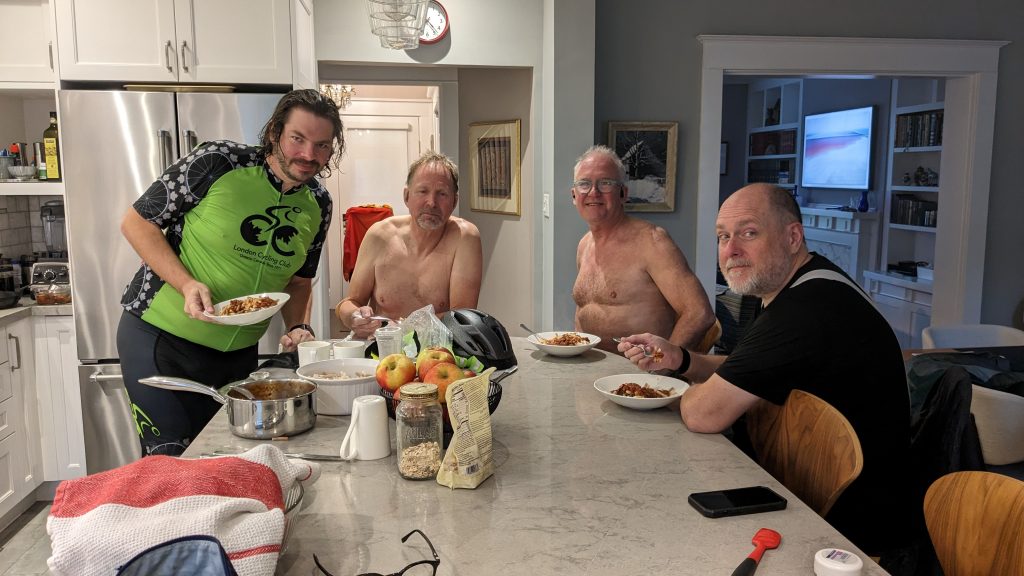
Vaune Davis is a legendary randonneuse from the Toronto chapter that, upon hearing about our route passing through Toronto, kindly offered to open her home up as a control stop. She waved us down from her back deck we parked our bikes in her yard, and went inside. The place smelled like a wonderful mix of waffles, spaghetti, and warmth. But given the state of us, Vaune shifted immediately from gracious hostess to war zone rescue medic.
“Quick, come in, take anything you need off! Don’t worry about the floor!” she said, ushering me inside.
“Hi, I’m Fred” I said, stalling in the entryway.
“We don’t need to do this right now…here, come in, take this wet stuff off!” Vaune replied in haste. I guess I really appreciated her focus.
Vaune had a lovely home which we wasted no time turning into an absolute disaster area. I was still standing in the foyer unsure of where to put my wet gear when I saw Tim walking around shirtless, and Rob had nothing on but a towel. Vaune was ushering around, with towels on her feet, mopping up everywhere we went. Then Marc finally showed up. Apparently the address I’d written down was off by a digit, and Marc had roused one of Vaune’s neighbours before finding the correct home. Marc was wearing civilized clothing and had remained dry all night, so surely he was not as scary looking as I might have been if I’d made the same mistake.
Vaune had prepared pasta for us, which we all ate ravenously. I remember her commenting about the fact that she couldn’t remember the last time she had so many half-naked people in her kitchen — I was glad to see she was taking some enjoyment out of the fact that we were laying waste to her home.
Once I had eaten, I stretched out on the couch and caught up on digital life. I checked the club slack app, and saw a few members who were following Guy’s SPOT tracker had noticed they’d been stopped in Brockville for quite some time, and were wondering if everything was okay. This prompted me to shoot a text over to JungAh to see where they were and how they were doing. She confirmed here that they’d spent some time in Brockville, and were now enjoying a nice breakfast. Also that while they’d battled wind through the night, their adventures with the rain were only just starting.
I also had an email from another Toronto randonneur, Paul Young. He said he’d settled in at a Starbucks further up our route on the eastern edge of Scarborough and was expecting us to come by soon and was hoping to wave us on. He noticed our tracker had stopped for awhile and wanted to know if everything was okay. I responded to him, thanking him for his interest, but said we’d taken refuge at a control and were probably going to maximize our two-hour stop limit here while we dried off and warmed up. Randonneuring people are awesome.
After that, taking the lead from my teammates, I may, or may not have slept for a few minutes.
By about 8:30 we needed to get moving as we were coming up to the end of our 2 hour stop limit. Our clothes had been dried in Vaune’s dryer, our shoes had been sitting on various registers, our bellies were full, and our spirits were lifted.
I was the first to head outside, back into the rain, and mount my bicycle. As I was opening up the back deck to head out into the street I saw a brightly coloured riding jacket on the other side of the gate. Paul Young had used my Garmin LiveTrack to pinpoint our location, and was coming for a visit. We chatted while the others got themselves together, then Paul wished us well as we left Vaune’s, eastbound into more rain. (Sorry about the mess Vaune!!)
* * *
JUNGAH: We made it to Athens just after 8AM just as the diner opened, and were just sitting down at a table before the skies opened up. Perfect timing! Apparently Guy and Peter had eaten at the SubWay while I slept like a corpse beside them so they weren’t as hungry as I was. I ordered a platter with some name like “The Hungry Man” and my teammates just watched me devour the whole thing. Apparently I was pretty impressive. It was here that I also got a text from Fred on the Huron team. He said were just getting ready to leave after a long stop drying off in Toronto. I let him know the rain had just started where we were.
I left Athens very happy. I had my first big meal of the day, and we were even able to head out without our rain gear on because the rain had let up. However within thirty minutes, it started pouring again. Peter and Guy stopped to put on their rain gear — they both had really fancy rain pants and everything. At first I was still in a bit of denial — I just kept hoping the rain would stop, so I kept moving. I would ride back and forth while the two were changing just to keep my core temperature up. Eventually though, when it became obvious that the rain wouldn’t stop, I too put my jacket on so I would keep warm, if not dry. We still had pretty bad headwind, and combined with the rain, it was beating me up pretty hard.
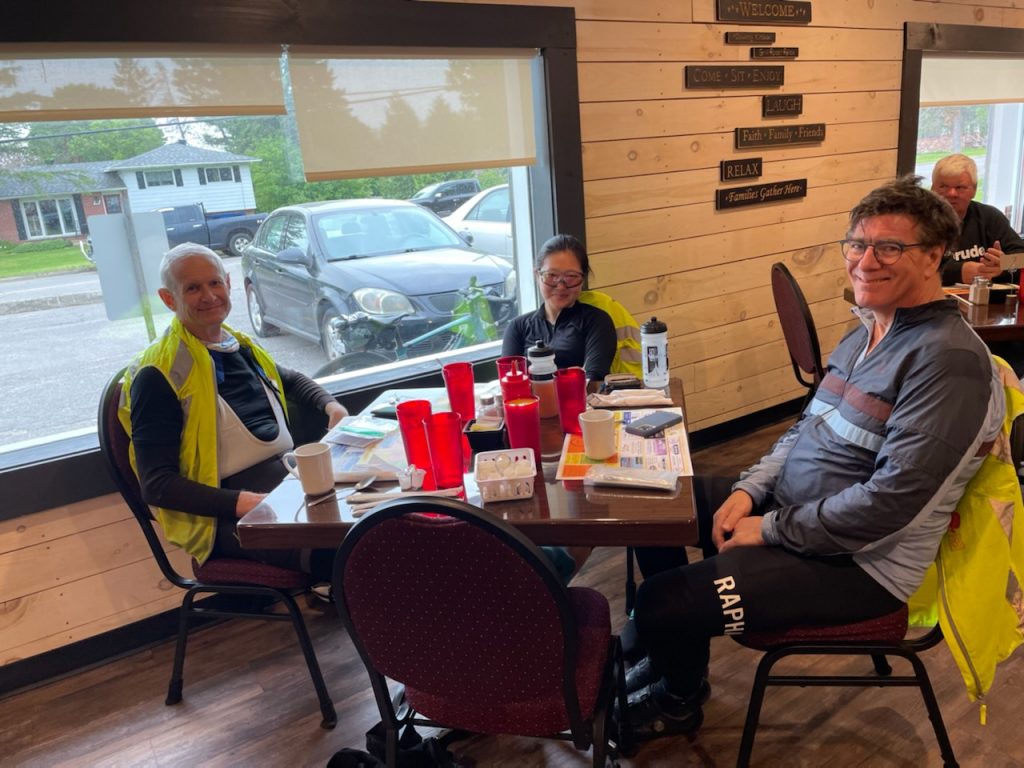
Our route passed between Lower Beverley Lake and Charleston lake, and we started to see a lot more climbing. To this point a lot of what we’d seen was just flat farm land, but now I was starting to hit the nice hills, and I was having a lot of fun. Just as we turned onto Burnt Hills Rd though Guy decided it was time to have a flat tire. We all stopped, but the mosquitos just swarmed me. So while Peter and Guy worked on repairing the flat, I rode back and forth up and down the hills. I probably added an extra five to ten kilometers to my ride before the two were ready to go again.
We pulled into Battersea just after noon, the control being a small corner store. I was actually still full from my big breakfast so I didn’t need much at this stop.
Checking in on our pace, we had about seven and-a-half hours to cover the remaining hundred kilometers to Belleville, which, even with the rain and wind, was looking pretty fast. So we rode on thinking we’d take a longer stop at our next control in Camden East.
* * *
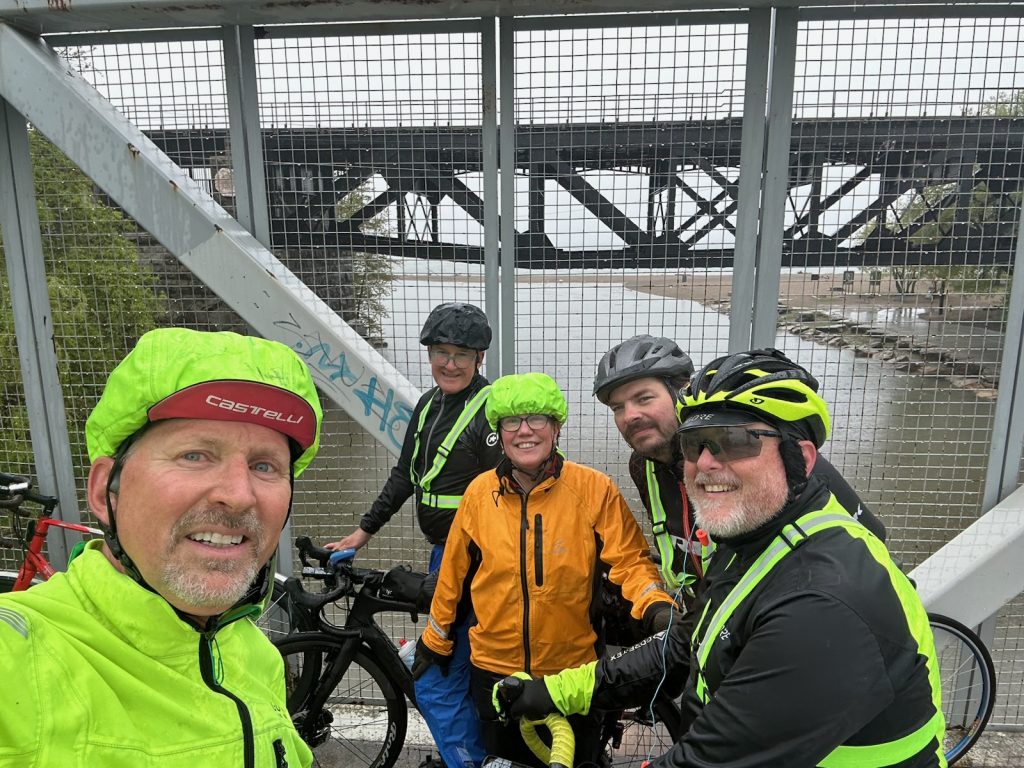
FRED: The ride out of the GTA was a grind. We rode through Scarborough along Kingston Rd, which was full of potholes and parked cars, and the Toronto city buses offered absolutely no passing buffer when passing a string of brightly coloured cyclists. We endured Lawrence Ave. and eventually Bloor St. through Oshawa, which was akin to pedaling on the side of a 400 series highway. There wasn’t much talking between our team during this stretch since the noise of the vehicles splashing through puddles of their own was so loud we wouldn’t hear each other anyway.
Still with the goal of making 400kms in mind, we made for a quick control stop in Pickering, but we were only ten minutes on the road before I admitted to Dave that I didn’t feel mentally ready to take on another leg without rest at that last stop.
Between Oshawa, through Bowmanville, to Coburg we had some interesting terrain choices. We finally left the loud busy highway in favour of Oshawa’s waterfront bike path. However any relief the group thought they’d get was dashed away by the realization that the river had breached it’s banks and was now washing all sorts of debris into the pathway — sometimes covering it entirely in murky water.
Just past Bowmanville we had another bit where the trail should have run through a field on some hardpack, but the rain had turned it completely to ankle deep mud and we had to hike our bikes about 500m through the field just to get back on tarmac.
It was along this hike-a-bike where I probably admitted to myself that even 400kms was not going to be achievable in a 24hr period.
* * *
JUNGAH: The afternoon was a quiet ride. There wasn’t much left to talk about amongst the team. The three of us just rode through the rain and endured. Just before three in the afternoon arrived at Camden East – a small hamlet to the north-east of Napanee, and at 315kms it was the site of our final control before arriving in Belleville.
We walked into the corner store in Camden East, and every step we took resulted in a big puddle. I went straight to the washroom to wash off the road debris from my face, and to dry off as much as I could.
Feeling a little more human I went back out into the store area and found Guy and Peter at the back of the store, sitting shamelessly in puddles of their own making, and eating slices of pizza. The store was narrow, and customers were literally stepping over the two randonneurs, and their puddles, to make their way around the store.
By the time I settled myself, I didn’t really notice Guy had disappeared, but he suddenly re-emerged from the stairwell he’d been hiding in, fully dressed in dry clothing.
“You just changed? What’s up there?” I asked him.
“Just a storage room.” he replied.
“Do you think I could sleep there?” I asked, knowing we had at least an hour to kill here.
Guy shrugged. “Sure. I don’t see why not?”.
I went upstairs into the closet area, which was big enough to have a lay down, and settled myself to sleep.
* * *
FRED: Soaking wet, cold, and all tired — the six of us sat around a Tim Horton’s table next to a fireplace and discussed our options.
“It’s 4 o’clock, and we’re at 340kms” Tim said. “At this point, I just want to know what everyone wants to do.”
“Honestly, I’m ready to stop.” I admitted. I took no shame in being the first to say it. There was a long silence, so I continued. “But here’s the thing: Ottawa’s now battling through the same rain we’ve had all night. Their route is about 370kms. We aren’t far from that ourselves. We can’t beat them at this point, but we can still meet that distance. And I think that’s a good way to finish this ride with my pride in tact.”
If anyone hated me for suggesting we continue, they were kind enough not to tell me. But I think most liked the idea of bringing the ride right to the 11th hour — after all — we couldn’t get any more wet than we already were, right?
We gave Marc instructions on where to park the truck, roughly 30kms from our control, and we set out. Because of our delay, we really only had just over an hour before our 6PM cutoff, so the five of us just hammered our pace, averaging well over 30kph. I had lost Tim, Brenda, and Rob in the fog ahead of me, and could only make out Dave’s headlight behind me, but by the time my Garmin read 6PM, the three in front had stopped. We called Marc — he was about 1 kilometer up the road. So we ended our ride recordings, gave each other high-fives for making 370kms, and rode out to our trailer.
It may have started pouring heavier when we were loaded into the truck, or maybe I just noticed it more. Or maybe, now that I was done, I was just empathetic to my Ottawa compatriots who still had two hours left in their own ride.
JUNGAH: It continued to rain all the way into Belleville. The route ended up on some really nice park paths that followed the river. This was such a nice way to end the ride, and it was here that I really appreciated the effort that Peter put into mapping and pre-scouting this route.
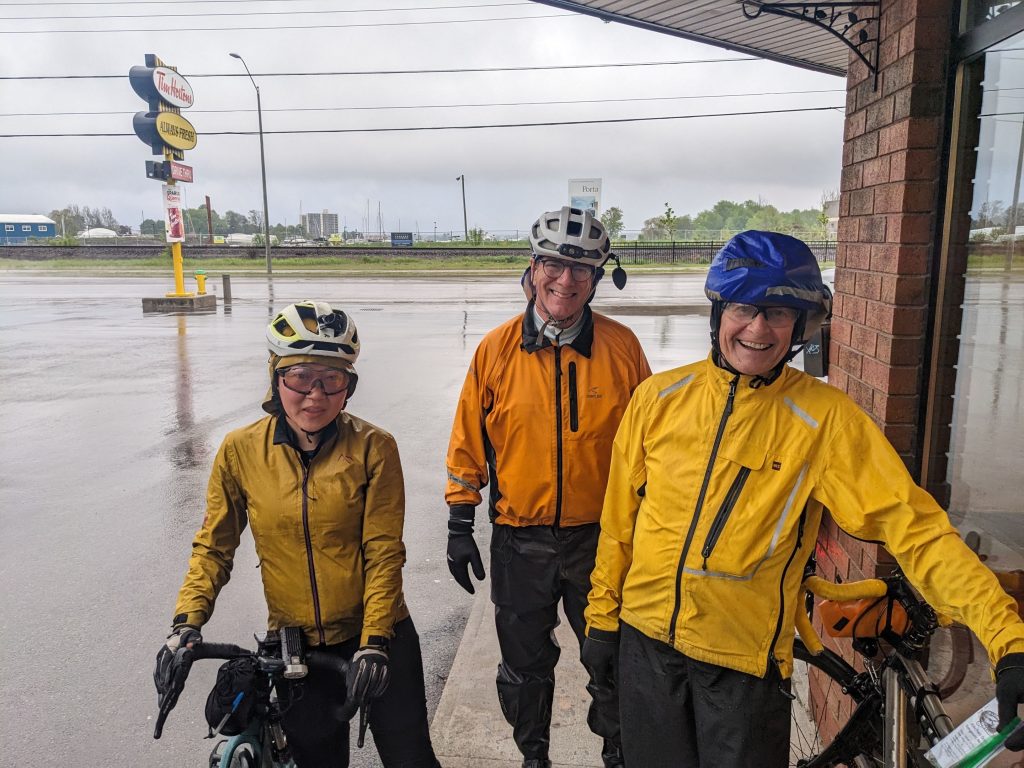
We arrived at the destination Tim Horton’s on Dundas street around 7PM, right on target. Vytas and Colleen were there to meet us. Vytas confirmed he hadn’t seen any sign of the Huron team, so we weren’t sure at this point what happened to them — but we knew we’d be meeting them for dinner at the Belleville Boathouse in an hour, so we assumed they were at their hotel getting dried off.
=-=-=-=-=- Ride Conclusion –=-=-=-=-=
In the end The Mangeurs de Fleche form Ottawa will take the award for this year’s Fleche, having completed their 370km course in the 24 hour time period. The Quintuplets de Belleville team from Huron, being unable to complete their audacious 500km target, had to cede this victory.
However the competition of the event was long forgotten by the time the two teams met for dinner. The sun had come out right on schedule that evening, just as the Ottawa team pulled into their stop. It wouldn’t leave for the remainder of the week, providing the province of Ontario with a sunny and warm May long-weekend.
The teams dined together at the Belleville Boathouse, sharing each their own stories from the road. They met again for breakfast the next day prior to heading home in respectively different directions.

